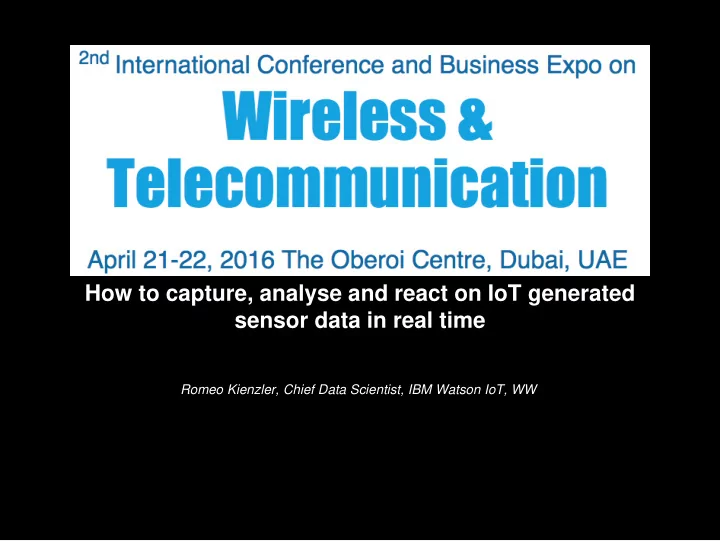

How to capture, analyse and react on IoT generated sensor data in real time Romeo Kienzler, Chief Data Scientist, IBM Watson IoT, WW
Why IoT (now) ? • 15 Billion connected devices in 2015 • 40 Billion connected devices in 2020 • World population 7.4 Billion in 2016
Why IoT (now) ? • 2016 90% of all data generated WW is at the edge of an IoT device • This data is never • captured • analysed • acted on
Why IoT (now) ? • 60% of data looses it’s value within milliseconds of being generated • New generation of Sensors • low cost • low energy consumption • low data transmission cost • long life batteries / self supplementary
• Energy consumption 0.33333333 µA • Cost 5 US$ • 600 mA/h • 70 days • 1 measurement /h • Cost 2 US$ • Energy consumption • Standby 3µA • Rx 30 mA • Tx 53 mA • Range 800m • Cost 50 US$
Why IoT (now) ? • If a tree falls in the forest we will hear it • IBM announced to invest 3 billion US$ • Opened IBM Watson IoT Global HQ in Munich, Germany • As of 2015 • 4000 IoT clients 170 countries 1400 partners 750 IoT patents 1000 Emloyees in HQ
IBM and Siemens • IBM partners with Siemens Buildings Technologies Division to maximise the potential of connected buildings • by the data they create (private side note)
IBM and KONE • IBM partners with KONE on Cloud-based Embedded intelligence in elevators and escalators
IBM and KONE • IBM partners with KONE on Cloud- based Embedded intelligence in elevators and escalators
How 2 IoT?
How 2 IoT? What is MQTT? • “light weight” telemetry protocol • Publish-Subscribe protocol via Message Broker • Invented by IBM 1999 • OASIS Standard since 2013
How 2 IoT?
How 2 IoT?
ApacheSpark the state-of-the-art in cloud based analytics Y MLBas Streamin Graph MLLi BlinkD SQL R O g X b B e U S Execution Layer (Spark Executor, YARN, Platform Symphony) T R E A Storage Layer (OpenStack SWIFT / Hadoop HDFS / IBM GPFS) M S Hardware Layer (Bare Metal High Performance Cluster) Intel Xeon E7-4850 v2 48 core, 3 TB RAM, 72 GB HDD, 10Gbps
Machine Learning on historic data Source: deeplearning4j.org
Online Learning Source: deeplearning4j.org
online vs. historic • Pros • Pros • all algorithms • low storage costs • abundance of software • real-time model update • model re-scoring / re- • Cons parameterisation (algorithmic improvement) • algorithm support • batch processing • software support • Cons • no algorithmic improvement • high storage costs • compute power to be inline • batch model update with data rate
DeepLearning DeepLearning Apache Spark Hadoop
Neural Networks
Neural Networks
Deeper (more) Layers
Convolutional
Convolutional + =
Convolutional
Learning of a function A neural network can basically learn any mathematical function
Recurrent
LSTM
http://karpathy.github.io/2015/05/21/rnn-effectiveness/
• Outperformed traditional methods, such as • cumulative sum (CUSUM) • exponentially weighted moving average (EWMA) • Hidden Markov Models (HMM) • Learned what “Normal” is • Raised error if time series pattern haven't been seen before
Learning of a program A LSTM network is touring complete
Problems • Neural Networks are computationally very complex • especially during training • but also during scoring CPU (2009) GPU (2016) IBM SyNAPSE (2018)
DeepLearning the future in cloud based analytics DeepLearning4J Y MLBas Streamin Graph MLLi BlinkD SQL R H2O O g X b B e ND4J jcuBLA U S S Execution Layer (Spark Executor, YARN, Platform Symphony) (cu)BL T AS R E A Storage Layer (OpenStack SWIFT / Hadoop HDFS / IBM GPFS) M S Hardware Layer (Bare Metal High Performance Cluster) AVX GPU Intel Xeon E7-4850 v2 48 core, 3 TB RAM, 72 GB HDD, 10Gbps, NVIDIA TESLA M60 GPU
Why IoT (now) ? Formal Definition (Romeo Kienzler, 2016) Cognitive IoT maximises efficiency of the system under observation by measuring all relevant parameters in order to (re)act accordingly to push the system into a state near to the global optimum
My Vision What if the majority of cars where connected and sensed? What if we can detect a state of unpreventable accidents? What if in such a case we just issue a 30% brake command to all vehicles? Still a dream?…
Do it yourself… • DeepLearning Architecture on-click cloud deployment • to be published: http://www.ibm.com/developerworks/analytics/ • to be announced: Twitter: @romeokienzler • Find this talk on youtube: http://ibm.biz/romeokienzler
Recommend
More recommend